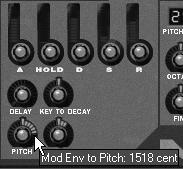| The NN-XT's many controls function much the same as the familiar ones from other devices. Filters, envelopes, and LFOs work the same way, except that the NN-XT gives a greater amount of control, allowing you to set all the parameters for individual samples or groups of samples. To adjust an individual sample 1. | Select the sample in the Remote Editor.
| 2. | Adjust any of the sample parameter knobs located below the Remote Editor display (Figure 6.112).
Figure 6.112. Sample parameter knobs 
| 3. | Deselect the sample, and watch the adjusted parameter go blank or to the default value.
| 4. | Again select the sample to check that the NN-XT has stored your new setting. This change will be stored when you save your patch.
|
To adjust multiple samples 1. | Select the desired samples in the Remote Editor (to select multiple samples, hold down Shift while clicking sample names).
| 2. | Adjust any of the group parameter knobs (Figure 6.113).
Figure 6.113. Group parameter knobs 
| 3. | Deselect the samples and then reselect to confirm that the changes you made are being remembered.
|
 Tip Tip
When creating large patches with many knob adjustments, it is strongly advised that you use groups whenever possible. This helps you to keep track of, check, and edit your settings quickly.
Modulating samples You may sometimes prefer a single-sample patch over a complex sound-mapping scheme as a way to use the sampler as a real-time sound processor. The NN-XT's mod envelope allows you to create pitch and brightness variations over the course of a note. It can modulate pitch, filter, or both, and can modulate positively (increasing pitch or filter frequency) or negatively (decreasing pitch or filter frequency). The NN-XT envelope ADSR controls (see Chapter 5) are knobs, and there's an additional hold stage that sets a length of time between the attack maximum and the decay stage. Hold settings include Off and a range from 0.3 milliseconds to 50.04 seconds. Since the mod envelope's attack, hold, decay, and release stages have a wide range (0.3 milliseconds to 50.04 seconds), they can be used to make very fast adjustments to a short sound like a drum hit, or very slowly evolving (3.336 minutes, in fact) variations to a sustained pad or ambience. To use the NN-XT mod envelope for pitch 1. | Load the Reason Factory Sound Bank /NN-XT Sampler Patches/Pads/FM Pad patch.
| 2. | Create a two-bar loop in your Sequencer NN-XT track and input a sustained note (Figure 6.114).
Figure 6.114. A two-bar sustained note for testing the FM Pad patch 
| 3. | In the Rack, select all the samples in the patch using the Edit > Select All Zones command, or by pressing Ctrl+A (Win)/ Cmd+A (Mac).
| 4. | Turn the mod envelope's Pitch knob to the right (Figure 6.115). When you play your loop, you'll hear the sample's pitch ramp up, hold, decay, sustain, and ramp down as the envelope runs through its stages. The Pitch knob sets how far the pitch will travel through each envelope stage. Turning it to the right will cause the pitch to rise with the attack, ramp down to the sustain frequency, and then ramp down for the release. Turning it to the left will cause the pitch to fall with the attack, ramp up to the sustain frequency, and then ramp up for the release.
Figure 6.115. The NN-XT mod envelope Pitch knob sends the envelope to the oscillator section. 
| 5. | Adjust the attack knob to speed up and slow down the initial pitch change.
| 6. | Adjust the decay knob to speed up or slow down how fast the pitch proceeds to the sustain frequency.
| 7. | Adjust the sustain knob to set the frequency at which the pitch will rest while the note sustains.
| 8. | Use the release knob to set the time that the pitch will take to ramp back to its starting frequency.
|
To use the mod envelope for brightness 1. | Load the Reason Factory Sound Bank /NN-XT Sampler Patches/Pads/FM Pad patch, if you haven't already, and create a two-bar loop with a sustained note in your Sequencer.
| 2. | In your NN-XT, set the mod envelope Pitch knob back to the middle.
| 3. | Since the mod envelope is an offset of your filter settings, make sure the NN-XT's Filter section is enabled (with the On/Off button) and your filter frequency (Freq knob) is tuned low enough so that positive filter movement by the mod envelope has the best effect.
| 4. | With your loop playing, turn the mod envelope Filter knob to the right. When you play your loop, you'll hear the brightness increase and decrease as the envelope runs through its stages (Figure 6.116).
Figure 6.116. The mod envelope Filter knob only has an effect if the Filter section is active. 
| 5. | Now set the filter frequency high, so that a negative mod envelope has an audible effect as it decreases.
| 6. | Turn the mod envelope Filter knob to the left, and you'll hear the brightness decrease and increase as the envelope runs through its stages.
| 7. | Adjust the mod envelope attack to speed up and slow down the initial change in brightness.
| 8. | Adjust the decay to speed up or slow down the filter frequency's progression to the sustain setting.
| 9. | Adjust the sustain stage to set the frequency at which the filter will rest while the note sustains.
| 10. | Adjust the release stage to set the time the filter will take to return to its starting frequency.
|
 Tip Tip
|
 Tip
Tip

